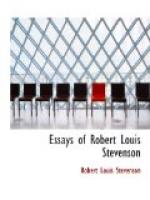For my part, I liked a story to begin with an old
wayside inn where, “towards the close of the
year 17—,” several gentlemen in three-cocked
hats were playing bowls. A friend of mine preferred
the Malabar coast[2] in a storm, with a ship beating
to windward, and a scowling fellow of Herculean proportions
striding along the beach; he, to be sure, was a pirate.
This was further afield than my home-keeping fancy
loved to travel, and designed altogether for a larger
canvas than the tales that I affected. Give me
a highwayman and I was full to the brim; a Jacobite[3]
would do, but the highwayman was my favourite dish.
I can still hear that merry clatter of the hoofs along
the moonlit lane; night and the coming of day are
still related in my mind with the doings of John Rann
or Jerry Abershaw;[4] and the words “postchaise,”
the “great North road,"[5] “ostler,”
and “nag” still sound in my ears like
poetry. One and all, at least, and each with his
particular fancy, we read story-books in childhood;
not for eloquence or character or thought, but for
some quality of the brute incident. That quality
was not mere bloodshed or wonder. Although each
of these was welcome in its place, the charm for the
sake of which we read depended on something different
from either. My elders used to read novels aloud;
and I can still remember four different passages which
I heard, before I was ten, with the same keen and
lasting pleasure. One I discovered long afterwards
to be the admirable opening of What will he Do
with It?[6] It was no wonder I was pleased with
that. The other three still remain unidentified.
One is a little vague; it was about a dark, tall house
at night, and people groping on the stairs by the
light that escaped from the open door of a sickroom.
In another, a lover left a ball, and went walking
in a cool, dewy park, whence he could watch the lighted
windows and the figures of the dancers as they moved.
This was the most sentimental impression I think I
had yet received, for a child is somewhat deaf to
the sentimental. In the last, a poet, who had
been tragically wrangling with his wife, walked forth
on the sea-beach on a tempestuous night and witnessed
the horrors of a wreck.[7] Different as they are,
all these early favourites have a common note—they
have all a touch of the romantic.
Drama is the poetry of conduct, romance the poetry of circumstance. The pleasure that we take in life is of two sorts—the active and the passive. Now we are conscious of a great command over our destiny; anon we are lifted up by circumstance, as by a breaking wave, and dashed we know not how into the future. Now we are pleased by our conduct, anon merely pleased by our surroundings. It would be hard to say which of these modes of satisfaction is the more effective, but the latter is surely the more constant. Conduct is three parts of life,[8] they say; but I think they put it high. There is a vast deal in life and letters both which is not




